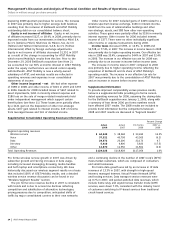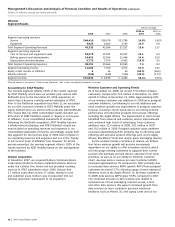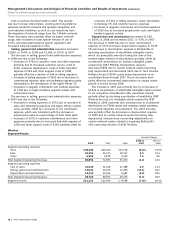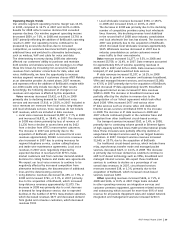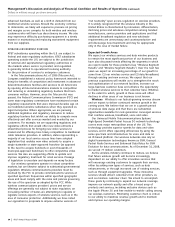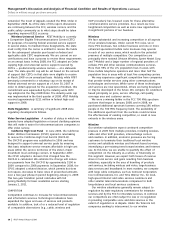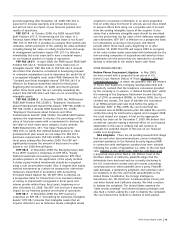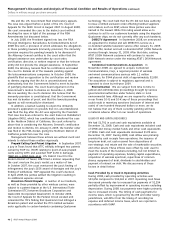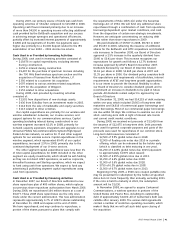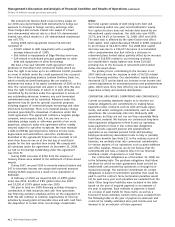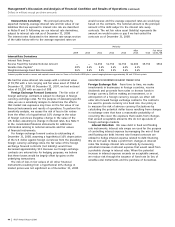AT&T Wireless 2008 Annual Report Download - page 36
Download and view the complete annual report
Please find page 36 of the 2008 AT&T Wireless annual report below. You can navigate through the pages in the report by either clicking on the pages listed below, or by using the keyword search tool below to find specific information within the annual report.
Management’s Discussion and Analysis of Financial Condition and Results of Operations (continued)
Dollars in millions except per share amounts
34
| AT&T Annual Report 2008
advanced handsets, as well as a shift in demand from our
traditional wireline services. Should the economy continue
to deteriorate, we likely will experience pressure on pricing
and margins as we compete for both wireline and wireless
customers who will have less discretionary income. We also
may experience difficulty purchasing equipment in a timely
manner or maintaining and replacing warranteed equipment
from our suppliers.
OPERAT I NG ENVIRONM E N T OVE R V IEW
AT&T subsidiaries operating within the U.S. are subject to
federal and state regulatory authorities. AT&T subsidiaries
operating outside the U.S. are subject to the jurisdiction
of national and supranational regulatory authorities in
the markets where service is provided, and regulation
is generally limited to operational licensing authority
for the provision of services to enterprise customers.
In the Telecommunications Act of 1996 (Telecom Act),
Congress established a national policy framework intended to
bring the benefits of competition and investment in advanced
telecommunications facilities and services to all Americans
by opening all telecommunications markets to competition
and reducing or eliminating regulatory burdens that harm
consumer welfare. However, since the Telecom Act was
passed, the Federal Communications Commission (FCC) and
some state regulatory commissions have maintained certain
regulatory requirements that were imposed decades ago on
our traditional wireline subsidiaries when they operated as
legal monopolies. Where appropriate, we are pursuing
additional legislative and regulatory measures to reduce
regulatory burdens that inhibit our ability to compete more
effectively and offer services wanted and needed by our
customers. For example, we are supporting regulatory and
legislative efforts that would offer new video entrants a
streamlined process for bringing new video services to
market and for offering more timely competition to traditional
cable television providers. In addition, states representing a
majority of our local service access lines have adopted
legislation that enables new video entrants to acquire a
single statewide or state-approved franchise (as opposed
to the need to acquire hundreds or even thousands of
municipal-approved franchises) to offer competitive video
services. We also are supporting efforts to update and
improve regulatory treatment for retail services. Passage
of legislation is uncertain and depends on many factors.
Our wireless operations operate in robust competitive
markets, but are likewise subject to substantial governmental
regulation. Wireless communications providers must be
licensed by the FCC to provide communications services at
specified spectrum frequencies within specified geographic
areas and must comply with the rules and policies governing
the use of the spectrum as adopted by the FCC. While
wireless communications providers’ prices and service
offerings are generally not subject to state regulation, an
increasing number of states are attempting to regulate or
legislate various aspects of wireless services, such as in the
area of consumer protection. Additionally, we have noted
our opposition to proposals to impose extreme versions of
“net neutrality” open access regulation on wireless providers.
It is widely recognized that the wireless industry in the
United States is characterized by innovation, differentiation,
declining prices and extensive competition among handset
manufacturers, service providers and applications and that
additional broadband regulation and new wholesale
requirements are unnecessary and counterproductive and
will discourage new investment and may be appropriate
only in the case of market failure.
Expected Growth Areas
We expect our wireless services and data wireline products
to remain the most significant portion of our business and
have also discussed trends affecting the segments in which
we report results for these products (see “Wireless Segment
Results” and “Wireline Segment Results”). Over the next few
years we expect an increasing percentage of our growth to
come from: (1) our wireless service and (2) data/broadband,
through existing and new services. We expect that our
previous acquisitions will enable us to strengthen the reach
and sophistication of our network facilities, increase our
large-business customer base and enhance the opportunity
to market wireless services to that customer base. Whether,
or the extent to which, growth in these areas will offset
declines in other areas of our business is not known.
Wireless Wireless is our fastest-growing revenue stream
and we expect to deliver continued revenue growth in the
coming years. We believe that we are in a growth period
of wireless data usage and that there are substantial
opportunities available for next-generation converged services
that combine wireless, broadband, voice and video.
Our Universal Mobile Telecommunications System/
High-Speed Downlink Packet Access 3G network technology
covers most major metropolitan areas of the U.S. This
technology provides superior speeds for data and video
services, and it offers operating efficiencies by using the
same spectrum and infrastructure for voice and data on
an IP-based platform. Our wireless networks also rely on
digital transmission technologies known as GSM, General
Packet Radio Services and Enhanced Data Rates for GSM
Evolution for data communications. As of December 31, 2008,
we served 77 million customers.
As the wireless industry continues to mature, we believe
that future wireless growth will become increasingly
dependent on our ability to offer innovative services that
will encourage existing customers to upgrade their services,
either by adding new types of services, such as data
enhancements, or through increased use of existing services,
such as through equipment upgrades. These innovative
services should attract customers from other providers, as
well as minimize customer churn. We intend to accomplish
these goals by continuing to expand our network coverage,
improve our network quality and offer a broad array of
products and services, including exclusive devices such as
the Apple iPhone 3G and free mobile-to-mobile calling among
our wireless customers. Minimizing customer churn is critical
to our ability to maximize revenue growth and to maintain
and improve our operating margins.


